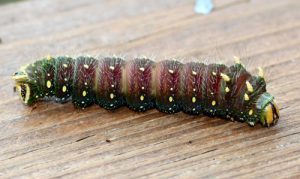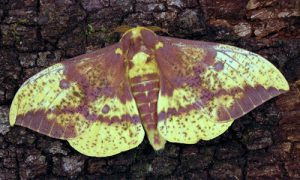 This large caterpillar is the larvae of the imperial moth, Eacles imperialis. It really does not do enough damage for us to worry about trying to control it. The imperial moth is found from southern New England south to the Florida Keys and west through the southern Great Lakes region to eastern Nebraska and central Texas.
This large caterpillar is the larvae of the imperial moth, Eacles imperialis. It really does not do enough damage for us to worry about trying to control it. The imperial moth is found from southern New England south to the Florida Keys and west through the southern Great Lakes region to eastern Nebraska and central Texas.
The larvae feed on pine (preferred source), maple, oak, sweetgum and sassafras. Mature larvae come in a variety of colors ranging from light to dark brown, burgundy, or green. The dark brown forms may be marked with burnt-orange patches dorsally and surrounding the breathing holes or spiracles. The area immediately around the spiracles is white in brown larvae and yellow in green larvae. The external spines of green larvae are yellow. Brown larvae are more common than green ones.
 Adults do not eat and live only a short period of time. They live long enough to find a mate, lay eggs then die. Eggs hatch in 10 days to two weeks depending on the temperature. Newly hatched larvae eat their egg shells. One other interesting fact about this caterpillar: they swallow air and expand to a length of 7-8 mm within about five minutes of hatching. Sounds like they are filling a balloon.
Adults do not eat and live only a short period of time. They live long enough to find a mate, lay eggs then die. Eggs hatch in 10 days to two weeks depending on the temperature. Newly hatched larvae eat their egg shells. One other interesting fact about this caterpillar: they swallow air and expand to a length of 7-8 mm within about five minutes of hatching. Sounds like they are filling a balloon.
For more complete information on this beautiful moth read the following UF/IFAS Featured Creatures publication: http://entnemdept.ufl.edu/creatures/bfly/moth2/imperial_moth.htm
 0
0
